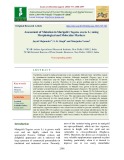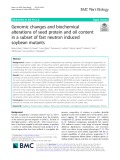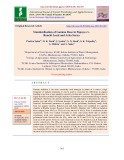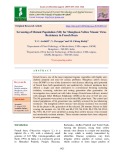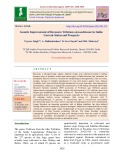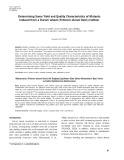
Induced mutation breeding
-
In Thailand, there are three major species of Colletotrichum spp. which caused anthracnose disease to chili product; Colletotrichum gloeosporioides, C. capsici and C. acutatum. In 2015, the researchers from Thailand Institute of Nuclear Technology reported a first success of radiation-induced mutation breeding for anthracnose resistance which caused by C. gloeosporioides in Sukhothai.
 7p
7p  vicedric
vicedric
 08-02-2023
08-02-2023
 4
4
 3
3
 Download
Download
-
Artificial mutagenesis not only provides a new approach to increase the diversity of desirable traits for breeding new varieties but are also beneficial for characterizing the genetic basis of functional genes.
 8p
8p  viansan2711
viansan2711
 30-07-2021
30-07-2021
 8
8
 1
1
 Download
Download
-
Induced mutations have proven flexible, workable and ready to use on any crop. In addition, it is a low-cost technology that has the ability to address current challenges in agriculture. The breeding of new mutant varieties with a higher yield potential will be the driving force to meet the challenges of the 21st century.
 8p
8p  nguathienthan8
nguathienthan8
 20-10-2020
20-10-2020
 7
7
 2
2
 Download
Download
-
Mutagens are known to widen range of genetic variation for characters in plant. Therefore, induced mutation breeding was initiated for augmenting its productivity. Result of this investigation presented in this paper.
 4p
4p  trinhthamhodang1215
trinhthamhodang1215
 23-09-2020
23-09-2020
 11
11
 1
1
 Download
Download
-
The development of fruits without fertilization is known as parthenocarpy. Parthenocarpy improves the fruit quality, processing attributes, production and productivity of vegetable crops like tomato, cucumber, watermelon etc. Absence of seeds can enhances the shelf life of the fruits, allowing a better conservation, fruit set in adverse climatic conditions, early and offseason production of vegetable crops. Therefore, it is important to ensure yield stability regardless of environmental conditions.
 20p
20p  gaocaolon5
gaocaolon5
 14-06-2020
14-06-2020
 14
14
 2
2
 Download
Download
-
Mutation breeding is one of the best ways to induce genetic variability within a crop species in a short period of time. It is equally a potentially powerful tool for cluster bean as other crops for genetic enrichment. The gamma radiation induced 190 M4 mutant lines of cluster bean [Cyamopsis tetragonoloba (L.) Taub.] obtained from Centre for Biotechnological Research (CBR), Dept. of BCI, College of Horticulture, Bengaluru and which were used for the field experiment on spikelet sterility during kharif 2017 (June - November) at College of Horticulture, Mysore.
 11p
11p  gaocaolon5
gaocaolon5
 14-06-2020
14-06-2020
 8
8
 2
2
 Download
Download
-
Studies on mutagenic efficiency and effectiveness of sodium azide on Indian mustard in M2 generation
Mutagenic efficiency and effectiveness is an important factor for the selection of a mutagen for a mutation breeding program. The mutagenic efficiency gives an idea of the proportion of mutation on relation to the other associated undesirable biological effects such as lethality, sterility and meiotic aberrations while mutagenic effectiveness is a measure of the frequency of the mutation induced by unit dose of mutagens. The usefulness of any particular mutagen in crop breeding depends not only on its mutagenic effectiveness but also on the mutagenic efficiency of the mutagen.
 4p
4p  gaocaolon5
gaocaolon5
 14-06-2020
14-06-2020
 16
16
 1
1
 Download
Download
-
Variability caused by induced mutations is not essentially different from variability caused by spontaneous mutation during evolution. Although marigold (Tagetes spp.) is an important commercial crop the major breeding obstacle is non-availability of known sources for creating a novelty. Therefore, in vivo grown seedlings and in vitro raised proliferated cultures of marigold cultivar Pusa Narangi Gainda were subjected to gammairradiation to develop mutant populations. 11 Mutants were grown in the M1 generation and variants screened based on yield and morphological characters.
 10p
10p  trinhthamhodang5
trinhthamhodang5
 16-05-2020
16-05-2020
 26
26
 1
1
 Download
Download
-
Chickpea (Cicer arietinum L.) is an important cool-season food legume grown extensively by the poor farmers throughout the Indian subcontinent. In India chickpea is being grown in 8.32 million hectare with production of 9.8 million tones and 925 - kg/ha productivity (Project coordinators report, 2014-15). The Dry root rot (DRR) of chickpea caused by necrotropic fungus Rhizoctonia bataticola.
 10p
10p  trinhthamhodang5
trinhthamhodang5
 16-05-2020
16-05-2020
 15
15
 1
1
 Download
Download
-
Increasing the productivity of rapeseed as one of the widely cultivated oil crops in the world is of upmost importance. As flowering time and plant architecture play a key role in the regulation of rapeseed yield, understanding the genetic mechanism underlying these traits can boost the rapeseed breeding
 12p
12p  vishikamaru2711
vishikamaru2711
 29-04-2020
29-04-2020
 14
14
 1
1
 Download
Download
-
Soybean is subjected to genetic manipulation by breeding, mutation, and transgenic approaches to produce value-added quality traits. Among those genetic approaches, mutagenesis through fast neutrons radiation is intriguing because it yields a variety of mutations, including single/multiple gene deletions and/or duplications.
 12p
12p  viharuno2711
viharuno2711
 21-04-2020
21-04-2020
 6
6
 0
0
 Download
Download
-
The experiment was carried out on gladiolus variety ‘Psittacinus Hybrid’ to know the best mutagen between physical mutagen (Gamma rays) and chemical mutagen (DES). The experiment was carried out at Floriculture Research Farm, ASPEE college of Horticulture and Forestry, Navsari during the year 2013-2014.
 8p
8p  trinhthamhodang4
trinhthamhodang4
 22-03-2020
22-03-2020
 8
8
 2
2
 Download
Download
-
Gamma radiation is the most commonly used mutagen in plants as it causes a high frequency of induced mutations. It can be used to overcome the difficulties in papaya breeding to get true to type plantlets especially in dioecious varieties. An optimum dose is highly desired to produce the high frequency of mutations with minimum killing of treated individuals. Therefore, the present investigation was undertaken to determine the LD50 of gamma rays and effect of different dosages of gamma rays on morphological, physiochemical, biochemical parameters of papaya.
 13p
13p  caygaocaolon2
caygaocaolon2
 11-03-2020
11-03-2020
 20
20
 0
0
 Download
Download
-
French bean is one of the most important legume vegetables with highly antidiabetic property and used for cardiac problems. Mungbean yellow mosaic virus (MYMV) is one of the destructive viral diseases affecting yield potential of french bean both quantitatively and qualitatively. Induced mutations have offered a single and short alternative to conventional breeding including isolation, screening, selection and testing generation after generation. An investigation was carried out with Arka Anoop (French bean cultivar), treated with mutagen Ethyl Methane Sulphonate (EMS) at the dose of 0.
 6p
6p  caygaocaolon3
caygaocaolon3
 09-03-2020
09-03-2020
 18
18
 1
1
 Download
Download
-
Berseem, a nitrogen-fixing, annual, multicut forage crop cultivated around 2 million hectares areas of northern, central and eastern parts of India. Berseem has variability for pollination behavior however variation for morphological and agronomic traits are scare, perhaps, because of initially introduction of crop with narrow genetic base. Genetic variability have been fortified through introduction of exotic materials, intra-interspecific hybridization, induction of polyploidy and mutation. ICAR-Indian Grassland and Fodder Research Institute maintain >900 accessions of Trifolium spp.
 9p
9p  nguaconbaynhay1
nguaconbaynhay1
 04-12-2019
04-12-2019
 22
22
 0
0
 Download
Download
-
Mutation breeding is one of the breeding methods used successfully in durum wheat for selecting lines with increased agronomic values. The aim of this study was to select mutant lines having a better agronomic potential than the mother variety Gediz-75 in the M6 and M7 generations. The mutants were derived from the variety Gediz-75 of durum wheat (Triticum durum Desf.).
 7p
7p  masterbarista
masterbarista
 14-01-2019
14-01-2019
 25
25
 1
1
 Download
Download
CHỦ ĐỀ BẠN MUỐN TÌM









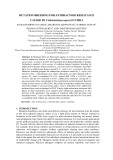
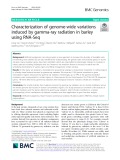
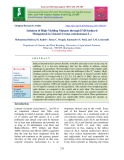
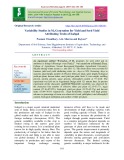

![Spikelet sterility studies on induced mutant populations of cluster bean [Cyamopsis tetragonoloba (L.) Taub.] Spikelet sterility studies on induced mutant populations of cluster bean [Cyamopsis tetragonoloba (L.) Taub.]](https://tailieu.vn/image/document/thumbnail/2020/20200614/gaocaolon5/135x160/681592129941.jpg)

